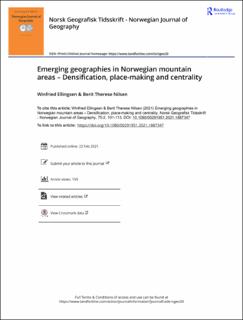Emerging geographies in Norwegian mountain areas – Densification, place-making and centrality
Peer reviewed, Journal article
Published version
Permanent lenke
https://hdl.handle.net/11250/3024034Utgivelsesdato
2021-02-22Metadata
Vis full innførselSamlinger
Originalversjon
10.1080/00291951.2021.1887347Sammendrag
In the mountainous hinterland of Norwegian cities new forms of habitation are emerging through mobility associated with second-home concentrations on mountain slopes. The guiding principle of this tangible spatial development is densification. The development is caused by a number of external and internal actors, each with their own agenda, geographical scale and trajectory. The objective of the article is to examine how various approaches to place-making and centre development affect and shape three case municipalities with a significant temporary population: Ringebu, Lesja and Røyrvik. Assemblage theory is employed as an analytical perspective, as the case municipalities are subject to various relations of exteriority. Based on interviews with relevant stakeholders and document analysis, the authors present the municipalities’ different backgrounds and contexts, as well as relevant planning priorities and practices, and discuss how these lead to highly different types of place-making. The main finding is that while subject to the same national regulations and market forces, the case municipalities’ approaches to local development have differed quite substantially. The authors conclude that different constellations of centrality constitute an important element in the municipalities’ place-making strategies and that more empirical studies are needed to illustrate how local practices can reinforce spatial distinctiveness.

